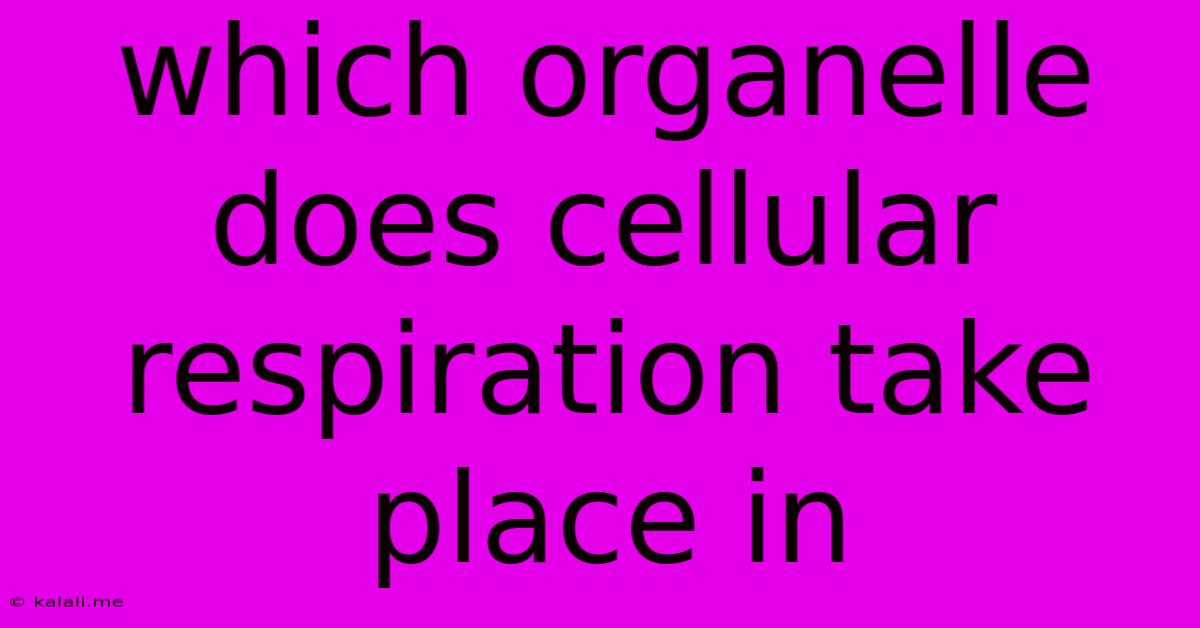Which Organelle Does Cellular Respiration Take Place In
Kalali
May 10, 2025 · 3 min read

Table of Contents
Which Organelle Does Cellular Respiration Take Place In? The Mighty Mitochondrion
Cellular respiration, the process that powers our cells and allows us to function, doesn't happen just anywhere within a cell. This crucial metabolic pathway is primarily localized within a specific organelle: the mitochondrion. This article will delve into the details of this vital process and why the mitochondrion is so crucial for life.
This article will answer the question of where cellular respiration occurs and explain the critical role of mitochondria in energy production, providing you with a comprehensive understanding of this fundamental biological process. We'll also explore the key stages of cellular respiration and how they are compartmentalized within the mitochondrion.
Understanding Cellular Respiration
Cellular respiration is the process by which cells break down glucose and other organic molecules to produce ATP (adenosine triphosphate), the primary energy currency of the cell. This energy is essential for all cellular processes, from muscle contraction to protein synthesis and nerve impulse transmission. The overall reaction can be summarized as:
C₆H₁₂O₆ + 6O₂ → 6CO₂ + 6H₂O + ATP
This seemingly simple equation belies a complex series of biochemical reactions that occur in several distinct stages.
The Mitochondrion: The Powerhouse of the Cell
The mitochondrion is often referred to as the "powerhouse of the cell" because it's the primary site of ATP production during cellular respiration. These double-membraned organelles possess their own DNA (mtDNA) and ribosomes, remnants of their endosymbiotic origin. This unique structure is key to their function. The two membranes—the outer mitochondrial membrane and the inner mitochondrial membrane—create distinct compartments within the mitochondrion, each playing a crucial role in the different stages of cellular respiration.
Stages of Cellular Respiration within the Mitochondrion
Cellular respiration is divided into four main stages:
-
Glycolysis: While technically not within the mitochondrion, glycolysis is the initial step, occurring in the cytoplasm. It breaks down glucose into pyruvate, producing a small amount of ATP and NADH (a reducing agent). Pyruvate then enters the mitochondrion.
-
Pyruvate Oxidation: Once inside the mitochondrion, pyruvate is converted into acetyl-CoA, releasing carbon dioxide. This stage occurs in the mitochondrial matrix, the space enclosed by the inner mitochondrial membrane.
-
Krebs Cycle (Citric Acid Cycle): The acetyl-CoA enters the Krebs cycle, also located in the mitochondrial matrix. This cyclical pathway further oxidizes the carbon atoms, releasing more carbon dioxide and generating ATP, NADH, and FADH₂ (another reducing agent).
-
Oxidative Phosphorylation (Electron Transport Chain and Chemiosmosis): This is the final and most significant stage of ATP production. It occurs across the inner mitochondrial membrane. Electrons from NADH and FADH₂ are passed along a chain of protein complexes, driving the pumping of protons (H⁺) from the matrix to the intermembrane space. This creates a proton gradient. The flow of protons back into the matrix through ATP synthase drives the synthesis of a large amount of ATP. Oxygen acts as the final electron acceptor, forming water.
Mitochondrial Dysfunction and Disease
The importance of mitochondrial function cannot be overstated. Mitochondrial dysfunction can lead to a wide range of diseases, collectively known as mitochondrial disorders. These conditions can affect various organs and systems, often resulting in fatigue, muscle weakness, and neurological problems.
In conclusion, the mitochondrion is undeniably the primary site where cellular respiration occurs. Its unique structure, with its compartmentalized membranes, allows for the efficient and controlled execution of the various stages of this critical energy-generating process, ultimately sustaining life itself. Understanding the mitochondrion's role in cellular respiration is essential for grasping the fundamental processes of life and the consequences of mitochondrial dysfunction.
Latest Posts
Latest Posts
-
How Much Can I Sell Bro For
Jul 02, 2025
-
How Many Bottles Is 64 Oz Of Water
Jul 02, 2025
-
How Many Ounces In Pound Of Meat
Jul 02, 2025
-
What Is The Diameter Of A Quarter
Jul 02, 2025
-
Spoon Gets Hot In A Bowl Of Soup
Jul 02, 2025
Related Post
Thank you for visiting our website which covers about Which Organelle Does Cellular Respiration Take Place In . We hope the information provided has been useful to you. Feel free to contact us if you have any questions or need further assistance. See you next time and don't miss to bookmark.